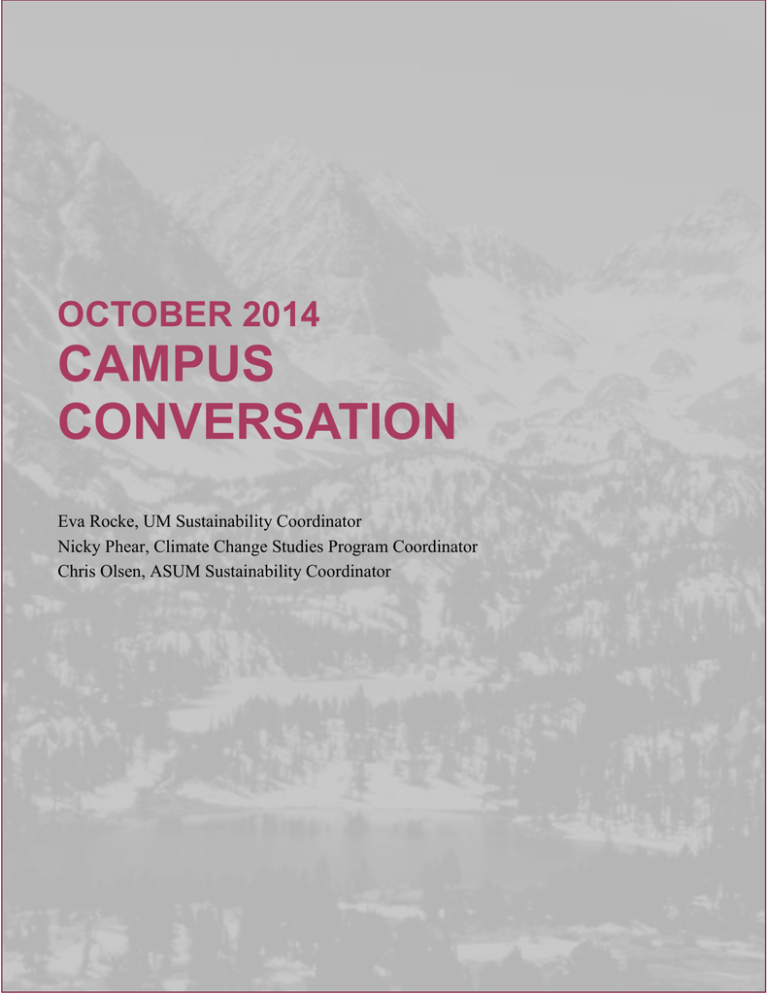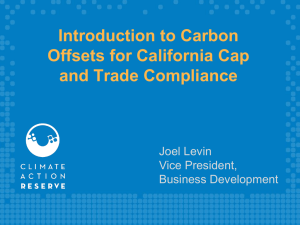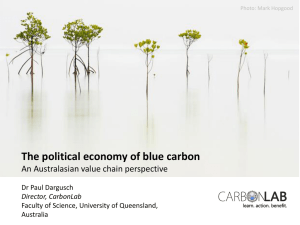CAMPUS CONVERSATION OCTOBER 2014
advertisement

OCTOBER 2014 CAMPUS CONVERSATION Eva Rocke, UM Sustainability Coordinator Nicky Phear, Climate Change Studies Program Coordinator Chris Olsen, ASUM Sustainability Coordinator INTRODUCTION On Thursday, October 30, 2014, sustainability partners at the University of Montana hosted the third Campus Climate Conversation in the University Center. Like past Conversations, this event drew students, faculty, staff, and administrators together to discuss how UM will advance its climate action goals. For the University of Montana to reach its ambitious emissions reduction goals, cross-campus collaboration, inclusive decision making, and engagement of all campus community members are absolutely necessary. The American College & University Presidents’ Climate Commitment (ACUPCC), of which UM is a charter signatory, commits us to carbon neutrality. In 2009, UM determined that 2020 would be our carbon neutrality target and we have since invested heavily in energy efficiency, conservation, and campus-wide engagement. However, carbon neutrality assumes that ACUPCC institutions will offset the portions of their emissions that are not eliminated with efficiency measures, behaviors like universityfunded air travel, daily commuting to and from campus by all university members, and travel related to athletics programs. All of these behaviors result in greenhouse gas emissions and must be offset or mitigated with carbon reductions elsewhere. Carbon offsets and Renewable Energy Credits (RECs) are controversial and complicated tools, but they will be a necessary component of UM’s climate action strategy if we are to reach neutrality. Accepting the role of offsets and RECs as a piece of UM’s climate action strategy, this Campus Conversation was focused solely on discussing these mechanisms for emissions reductions. The organizers of this event generated 3 goals for the conversation: 1. Educate our campus community about carbon offsets and possible projects. 2. Inspire ongoing engagement and collaboration across campus. 3. Brainstorm what types of offsets UM might purchase, how to prioritize offset characteristics, and generate recommendations for new policy and practices. This summary will be used by a working group of the Sustainable Campus Committee (SCC) to draft a university policy for carbon offset and REC purchasing. THE EVENT- SPEAKERS, TOPICS, AGENDA A total of 75 students, faculty, staff, and administrators from across the Main Campus and Missoula College attended the fall 2014 Campus Conversation. Participants were welcomed by President Engstrom before hearing presentations that covered the details of UM’s carbon neutrality commitment; the difference between Renewable Energy Credits (RECs) and carbon offsets; the criteria carbon offsets must meet in order to meet ACUPCC standards; and how other universities around the country have chosen to fund offsets and incorporate them into their climate action strategies. Following the presentations, participants were asked to focus on the discussion questions listed below and deliberate with others at their table. Each table included a note-taker and a facilitator who was responsible for keeping the conversation focused and respectful. To conclude the evening, each table presented “key themes” from their discussion to the entire group and completed a participant survey. The evening also included delicious (and Montana made) appetizers from UM Dining that were generously donated in support of UM sustainability efforts. The event agenda and Resource Guide are separate documents that 1 may serve as useful references to the context provided before the evening’s presentations and discussion questions. Discussion Questions: 1.) What criteria should be prioritized in the purchase of carbon offsets or Renewable Energy Credits (RECs)? Consider: Local/regional or international projects, type, cost, if certified. 2.) How should offsets be paid for in the future? Where should funding come from? Who should pay for these emissions reductions and by what mechanism? Consider: centrally by administration, by departments, by colleges, by students or faculty who travel using fossil fuels? 3.) What are key pieces of a new carbon offset policy? Consider how to integrate carbon accounting and offset project evaluation into our curriculum, research, and University procedures. DISCUSSION THEMES THE IMPORTANCE OF LOCAL & EDUCATIONAL One factor to consider when purchasing offsets is the “story” that will be told through the investment. In other words, what sorts of values and priorities are embodied in the offsets UM purchases? Are there cobenefits of an offset? Is the focus of the investment on “local” or an educational objective? Is the investment supporting the further development of renewable energy in a state where options for alternative energy are limited? Will the offset project be meeting multiple project partners’ objectives? One of the most common themes to arise in table discussions was the importance of having long-term offset investments illustrate and support the university’s educational mission. All eight tables noted the value of making the carbon offsets educational in some way. A few tables suggested that the offsets should be designed and certified by UM students or that UM students could potentially become trained in offset certification. Two tables noted the challenge of certifying offsets, developing them, AND having this entire process involve students, given the immediacy of our reduction goals and the complicated steps involved in certification. Some tables acknowledged that the offset projects could be educational to students and support local economic development but not necessarily be designed by students. Recognizing that Missoula and UM already have numerous projects underway or in development that could further our emissions reduction goals, three tables noted the importance of building upon these existing projects and leveraging the work of our community and campus partners. One table suggested a “Call for Proposals” for offsetting projects that would be open to campus and community groups. Making the review process competitive could serve to make the quality of the projects higher while simultaneously creating awareness of UM’s offsetting goals. When discussing the value of international offsets and local offsets, participants agreed on the value of both options, with two tables noting the importance of supporting a diverse selection of projects. Two groups agreed that identifying international offsetting projects located in communities abroad where UM conducts research or educational programs would serve as a link between UM’s sustainability goals, educational mission, and the economic development of host communities. One participant suggested UM support a substantial and very visible local project that would effectively convey our “sustainability story,” and then spend the remaining funds on offsets or RECs that might be more cost effective. All of the tables discussed the importance of any offset investment being measurable and real and that all campus community members are able to identify how their money is spent. 2 FUNDING SOURCES & AVOIDING THE NEED It is no secret that UM has experienced substantial budget cuts over the last few years and that this has resulted in shortages of staff and faculty, less funding for travel and professional development, and numerous other sacrifices across campus. The challenge of fundraising for something as politically controversial as carbon offsets during times of financial stress was not overlooked by any table. However, rather than focusing on the challenge of paying for offsets, participants discussed creative and diverse ways of generating resources on campus. A popular idea was that UM should consider building the cost of offsets into travel budgets across departments. In other words, the university could implement a self-imposed “carbon tax” on air travel, potentially as a flat percentage of total travel budget, a percentage of air travel budget, or as a small fee calculated based upon mileage and carbon emitted (example: $2/MTeCO2 emitted by travel itinerary). Some participants felt that this tax should be distributed evenly across campus, while others emphasized the importance of taxing those with the greatest footprint. In UM’s case, the athletics program would be responsible for a substantial portion of the cost of offsets, particularly in years when they need to travel more, if the tax was calculated based on amount of travel. This raised an interesting challenge for a few of the tables; charging for offsets for air travel that is the result of a successful athletic team, a staff person pursuing professional development, or a student studying abroad felt problematic to some participants. Opinions on whether a carbon fee on departments or individuals should be voluntary or mandatory varied considerably. Those who supported a voluntary fee felt that this would require greater buy-in from campus community members and would inspire more cross-campus engagement to elicit contributions. Two tables considered the possibility of an additional “tax” on athletic tickets and those funds generated from gym memberships or other fees already being collected across campus. Some components of revenue generation were universally supported, including: all departments and operations should be incorporated into the plan so that the cost is felt across campus; transparency is important—anyone should be able to learn how carbon offset funds are being spent; finally, the values of the university that are being embodied in an offset policy should be made clear so that there is a connection between a carbon fee and our institutional sustainability values for those paying for the offsets. Several tables also noted the value of incentivizing those behaviors that result in a smaller carbon footprint, like telecommuting, driving less to campus, and being more selective about conferences or trainings to attend. Carbon offsets are a behavior or expenditure-linked tax; a few participants felt that a carbon offset policy should incorporate (or at least consider) ways to incentivize behaviors that shrink our footprint that could be coupled with a carbon tax for additional potential reductions. 3 SURVEY RESULTS To complement the qualitative data from table discussions, quantitative data were collected from participants by way of pre- and post-survey questionnaires completed at the start and close of the campus conversation. The numbers below indicate the percentage of respondents. Preferred Type of Carbon Offset Projects 84.7 89.3 71.2 80.4 Pre Post 45.8 48.2 30.5 26.8 Renewable Energy Energy Efficiency Forest Management Waste Heat Recovery 8.5 14.3 18.3 12.5 Rangeland Management Methane Collection 1.7 0.0 None Graph 1: Responses to the question “If a carbon offset program were created, what type of offset project would you prefer the University supports?” Respondents were asked to choose up to 3 answers. (n=59.) Admin/staff were more inclined to support forest management (71%) than were faculty (26%). Priority Aspects of Carbon Offset Projects 84.7 92.9 Local or Regional 62.7 44.6 39.0 48.2 35.6 32.1 16.9 39.3 Certified Cost Type (listed in Graph 1) International Pre Post 3.3 0 None Graph 2: Responses to the question, “Which aspects of carbon offset projects should be considered as the highest priorities?” Respondents were asked to choose up to 3 answers. (n=59.) Preference increased for both international and local/regional projects, as well as cost consideration. Carbon Offset Policies: Support and Opposition (post Conversation) Support or Strongly Support 100 87.5 0 Education and Outreach Oppose or Strongly Oppose 81.5 8.9 Tracking Mileage 9.3 Voluntary fee 71.4 16.1 Mandatory fee 44.6 26.8 Caps for air travel Graph 3: Comparison of support and opposition for various carbon offset policies for University personnel. (n=59.) Following the conversation, support for each of the policies increased, particularly in regard to tracking mileage and support for both voluntary and mandatory fees. 4 CONCLUSIONS The fall 2014 Campus Climate Conversation provided an opportunity to gather cross-campus input and recommendations for a new carbon offset policy that will assist the University in achieving its emissions reduction goals. The following guidelines draw from the survey and table discussion findings and reflect the input of a diversity of students, faculty, staff, and administrators from a broad sector of campus (including International Programs, Athletics, the Global Leadership Initiative, Outdoor Programs, various academic departments, student government and student clubs, Facilities Services, Missoula College, and more). GUIDELINES FOR A CARBON OFFSET POLICY Education is key: Regardless of the type of offset purchased, education must be a central goal, aligning a carbon offset policy to UM’s educational mission and providing opportunities to raise awareness and understanding of offsets. Local projects are particularly good for telling UM’s “story” about dynamic and engaging education, long-term sustainability, and support for the Montana economy. Co-benefits are also key: Local or regional carbon offsets with co-benefits are preferred for at least some of the offsets/funds, as are international projects in areas where students study abroad and/or faculty conduct research. Diversity of offsets: Renewable energy, energy efficiency, and forest management are the most favored types of carbon offsets. However, more important than the specific type of offset selected are the location of offsets, their certification, and cost. RECs and offsets from the carbon market are useful for meeting our carbon neutrality goals within a budget. Certification: Certification of the offsets UM purchases is important, although not absolutely necessary. While participants agreed that local, UM-developed projects should be measureable, not all agreed that they need to be certified. Tracking and Transparency: Tracking mileage at the departmental level is important for ensuring accurate accounting and reporting. Furthermore, a carbon offset program should allow anyone to see how carbon offset funds are spent. The program should be well-organized and frequently communicate with the campus community about offset purchases. Outreach and education of the campus community is key. Funding: The cost of offsets or RECs should be distributed across campus, though logically connected to the greatest emissions sources. Popular (or frequently discussed) options included: o Implement a voluntary or mandatory carbon tax on all air travel or travel budgets o Calculate a Departmental fee based on the carbon footprint of particular activities o Charitable giving opportunity through the UM Foundation A few tables noted the importance of there being a “central purchasing coordinator” for offsets on campus, as well as bylaws and/or concrete purchasing guidelines. UM should also explore a community or institutional partner with whom we might collaborate on projects. 5 Incentives vs. Disincentives: Positive, low-emitting behaviors should be reinforced in whatever policy is developed, along with a “tax” for emissions-heavy behaviors. Some UM community members favor implementing a cap for air travel.



